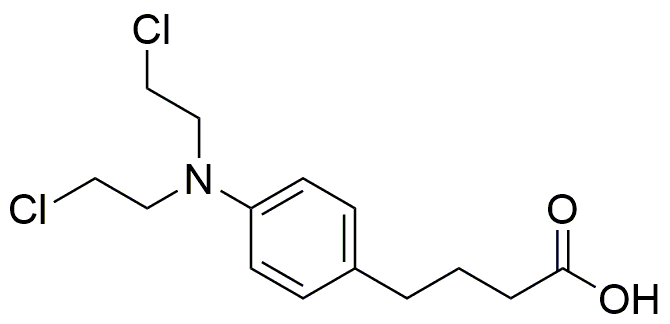Chlorambucil is widely utilized in research focused on:
- Cancer Treatment: Primarily used in oncology, it serves as a chemotherapy agent for treating chronic lymphocytic leukemia (CLL) and Hodgkin's lymphoma, helping to slow down cancer cell growth.
- Immunosuppressive Therapy: Employed in organ transplantation and autoimmune diseases, it helps suppress the immune response, reducing the risk of organ rejection and managing conditions like rheumatoid arthritis.
- Pharmaceutical Research: Used in drug development studies, chlorambucil aids researchers in understanding the mechanisms of action of alkylating agents and their effects on DNA, providing insights for creating new therapies.
- Veterinary Medicine: It is also applied in veterinary oncology for treating certain types of cancers in animals, offering a therapeutic option where traditional treatments may be less effective.
- Combination Therapies: Often used in combination with other chemotherapeutic agents, chlorambucil enhances treatment efficacy, allowing for lower doses of each drug and potentially reducing side effects.
Informations générales
Propriétés
Sécurité et réglementation
Applications
Chlorambucil is widely utilized in research focused on:
- Cancer Treatment: Primarily used in oncology, it serves as a chemotherapy agent for treating chronic lymphocytic leukemia (CLL) and Hodgkin's lymphoma, helping to slow down cancer cell growth.
- Immunosuppressive Therapy: Employed in organ transplantation and autoimmune diseases, it helps suppress the immune response, reducing the risk of organ rejection and managing conditions like rheumatoid arthritis.
- Pharmaceutical Research: Used in drug development studies, chlorambucil aids researchers in understanding the mechanisms of action of alkylating agents and their effects on DNA, providing insights for creating new therapies.
- Veterinary Medicine: It is also applied in veterinary oncology for treating certain types of cancers in animals, offering a therapeutic option where traditional treatments may be less effective.
- Combination Therapies: Often used in combination with other chemotherapeutic agents, chlorambucil enhances treatment efficacy, allowing for lower doses of each drug and potentially reducing side effects.
Documents
Fiches de données de sécurité (FDS)
La FDS fournit des informations de sécurité complètes sur la manipulation, le stockage et l’élimination du produit.
Spécifications du produit (PS)
Le PS fournit une description complète des propriétés du produit, notamment sa composition chimique, son état physique, sa pureté et les exigences de stockage. Il détaille également les plages de qualité acceptables et les applications prévues du produit.
Certificats d'analyse (COA)
Recherchez des certificats d'analyse (COA) en saisissant le numéro de lot du produit. Les numéros de lot et de lot se trouvent sur l'étiquette d'un produit, après les mots « Lot » ou « Lot de fabrication ».
Numéro de catalogue
Numéro de lot/série
Certificats d'origine (COO)
Ce certificat d'exploitation confirme le pays dans lequel le produit a été fabriqué, et détaille également les matériaux et composants utilisés et s'il est issu de sources naturelles, synthétiques ou autres sources spécifiques. Ce certificat peut être requis pour les douanes, le commerce et la conformité réglementaire.
Numéro de catalogue
Numéro de lot/série
Fiches de données de sécurité (FDS)
La FDS fournit des informations de sécurité complètes sur la manipulation, le stockage et l’élimination du produit.
DownloadSpécifications du produit (PS)
Le PS fournit une description complète des propriétés du produit, notamment sa composition chimique, son état physique, sa pureté et les exigences de stockage. Il détaille également les plages de qualité acceptables et les applications prévues du produit.
DownloadCertificats d'analyse (COA)
Recherchez des certificats d'analyse (COA) en saisissant le numéro de lot du produit. Les numéros de lot et de lot se trouvent sur l'étiquette d'un produit, après les mots « Lot » ou « Lot de fabrication ».
Numéro de catalogue
Numéro de lot/série
Certificats d'origine (COO)
Ce certificat d'exploitation confirme le pays dans lequel le produit a été fabriqué, et détaille également les matériaux et composants utilisés et s'il est issu de sources naturelles, synthétiques ou autres sources spécifiques. Ce certificat peut être requis pour les douanes, le commerce et la conformité réglementaire.


